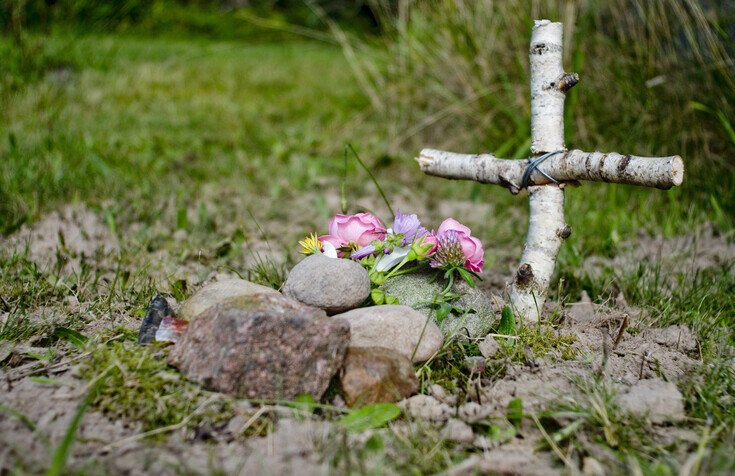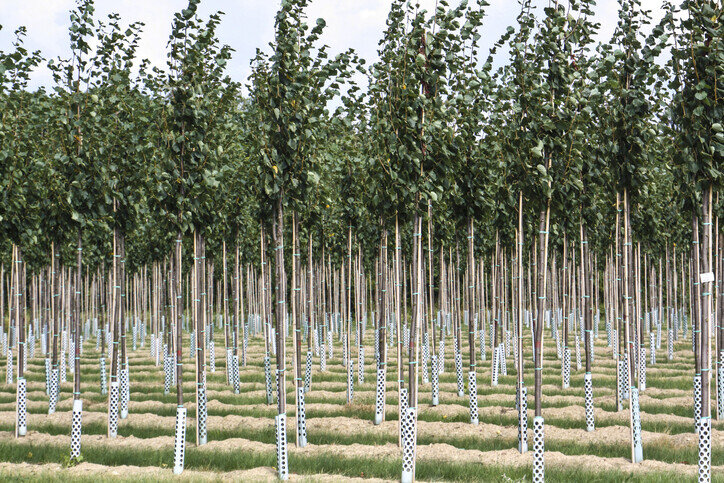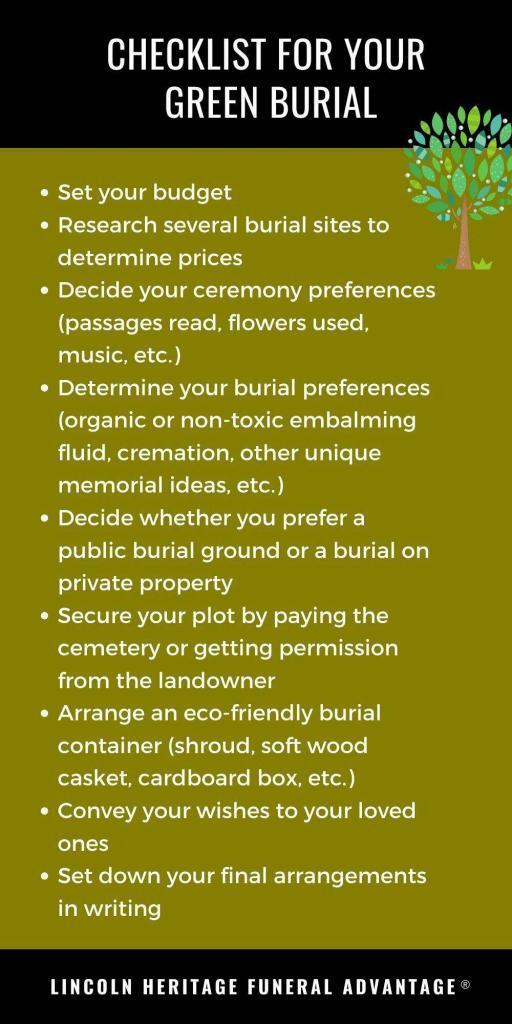Guide to Green Burial – A Natural Approach to Funerals

Environmental stewardship doesn’t need to stop at the end of life. Many people have begun viewing their final wishes through a green lens, taking the opportunity to help protect the environment when they pass away. This natural approach to funerals has led to an increase in green burial cemeteries, green burial caskets, and even green funeral ceremonies like a tree burial. In fact, a 2017 survey by the National Funeral Directors Association found that more than half of respondents (53.8 percent) expressed their intent for eco-friendly burial options.
Only you and your loved ones can decide if a natural burial is the right choice for your family. The following article will introduce you to green burial and provide details on the typical costs and options available when choosing a natural burial. Use this information when planning your funeral or discussing your wishes with your loved ones.
Table of Contents
What Is a Green Burial or Funeral?

The characteristics of a green funeral will vary, but most share several similarities aimed at reducing the environmental impact of end-of-life arrangements. In most cases, these burials use materials and storage containers that are biodegradable and environmentally friendly by avoiding:
- Embalming fluids
- Cement or metal coffin vaults
- Clothing made from certain materials
Natural burials don’t use traditional embalming fluid. There are alternative chemical-free embalming oils that may be used instead when needed. These essential oils degrade without leaving trace chemicals in the soil.
Typical Options for a Natural Burial
For a more conventional approach, there are many ways to ensure your final arrangements are environmentally friendly. And with each option, there are plenty of things to consider. Do you want to be buried in a set location that your visitors know? Do you want to be cremated and have your ashes scattered? Do you want to have a traditional burial, but have it performed by a green funeral home/cemetery?
Because of the wide variety of options available today, it’s important to make sure your final wishes are written down and that your preferences are clearly listed. Include where you’d like the burial to take place, such as a mortuary that is certified to perform green services. Among the things you should specify are:
- Ceremony preferences (passages read, flowers used, music, etc.)
- Preferences for biodegradable coffins, organic or non-toxic embalming fluid, etc.
- Whether or not to have a viewing beforehand
If the idea of becoming one with nature is appealing to you, there are a wide variety of unique options to consider:
- Capsula Mundi is an Italian concept that encapsulates the body in an egg-shaped organic container to feed a tree that’s planted above it.
- Eternal Reefs is a company that uses cremated ashes to create an artificial reef ball that is added to a living coral reef, which helps restore marine habitats by attracting fish and other organisms.
- Celetis Memorial Spaceflights will send cremated remains into space.
Why Choose a Natural Option?
There is nothing new or revolutionary about eco-friendly burials. Most burials before the mid-19th century were conducted this way, and many traditions still call for it. The reasons for selecting this type of burial vary from person to person, but the major motivations for this type of service are:
- Cost-savings. Green burials are typically cheaper than traditional burials because you don’t need to purchase a traditional casket.
- Environmentally friendly. They have less of an impact on the environment because of the materials used.
- Spiritual significance. Many people feel a special connection with nature. This approach allows the deceased to return to the earth naturally.
Costs
As with most funeral costs, prices for green funerals vary widely based on region and the type of burial site. Plots for green burials in a eco-friendly cemetery, for example, tend to be larger than those in a conventional cemetery so they may cost more.
For this type of burial, it typically costs $1,000 – $4,000 and usually includes a burial plot, fees to open and close the grave, a plot marker, and a one-time endowment to a perpetual care fund to maintain the property as a natural burial site. It does not include the cost of a funeral or memorial service or any processing/transporting of the body.
The cost for a gravesite and interment range from $200 to $1,000 for cremated remains. Keep in mind these charges do not include the cost of the cremation process itself, which averages $1,000-$2,500 and is handled by a funeral home, mortuary, or crematory. Be sure to shop several funeral homes to find a fair price. Keep in mind you can save money by providing your own casket. The law requires funeral homes to accept any appropriate burial container without assessing an additional fee. So-called “earth-friendly caskets” may be unnecessary and add thousands of dollars to the final bill.
Below is chart of typical green burial items and their associated costs:
| Item | Cost |
|---|---|
| Burial | $1,000 – $4,000 |
| Plot | $750 – $3,500 |
| Opening and Closing the Grave | $300 – $700 |
| Ash Scattering | $200 – $300 |
| Ash Burial | $200 – $1,100 |
| Biodegradable Urn | $65 – $350 |
Because green burial gives you the freedom to decline unnecessary services and merchandise, it is generally easier on your budget. In a green cemetery, you usually won’t pay for a large headstone or the associated costs of installation. But that doesn’t mean you shouldn’t consider your budget. Because of its increasing popularity, a cost of $5,000 or more is not unheard of for a green burial with a simple pine casket. You can help your loved ones cover your costs by applying for final expense insurance, also known as funeral insurance or burial insurance.
Natural Burial Sites

Natural burial promotes the restoration of poor soil areas and allows for long-term reuse of the land. Natural burial sections typically do not allow upright monuments. Individual graves are identified with a marker flush with the ground at the head of the body. The markers may be a natural rock or a plaque, although they are not typically set using concrete. Some natural burial sites choose to have no physical markers, instead indicating grave locations recorded by GPS. To preserve the pristine natural landscape and protect native plants and wildlife, most green cemeteries limit personal plantings and memorial decorations like potted flowers, wreaths, flags, chimes, and balloons.
If this approach appeals to you, you will need to search for specific green funeral homes or natural cemeteries that are certified to perform burials this way, and you may need special permission from your state or county to be buried naturally. Some states allow you to conduct a burial on private land, but this differs from state to state. If this appeals to you, be sure to check your state laws.
Hybrid Cemeteries
A hybrid cemetery is a conventional cemetery that offers the essential aspects of natural burial, either throughout the cemetery or in a designated section. Hybrid cemeteries can earn a certification that does not require them to use vaults. This will allow you to use any eco-friendly, biodegradable burial container such as a shroud or a soft wood casket.
Natural Burial Grounds
The goal of a natural burial ground is to restore or preserve a natural landscape populated by native vegetation and wildlife. Many support sustainable management through land conservation efforts by avoiding fertilizers, pesticides, or herbicides to encourage native habitats.
Conservation Burial Grounds
Conservation burial takes environmental stewardship a step further, committing burial fees to pay for land acquisition, protection, restoration, and management. These tend to be expansive tracts of land, sometimes contiguous with an existing park, critical habitat area, wildlife refuge, or nature conservancy area.
Choosing a Cemetery
Every cemetery has its own policies. For example, many green cemeteries do not use any machinery or heavy equipment for digging the gravesite. Instead, the gravesites are dug by hand. But this is not necessarily the rule. In addition, some natural cemeteries have very strict limitations on the decorations permitted on-site, while others encourage unique decor throughout the grounds. Unlike traditional cemeteries, many natural burial grounds permit flowers and other plants to be grown directly on top of the gravesite.
Be sure to inquire about any special restrictions before buying a plot. If you have very specific wishes, consult with a few locations to make sure your final requests will be honored.
Green Burial Caskets
Green caskets made of plain wood, wicker, and even cardboard are acceptable – and encouraged – at most green cemeteries. There are many new products that cater to these types of burials, including biodegradable containers that are made from paper, cardboard, willow, sea-grass, or bamboo that can break down with little environmental impact.
Supplying your own green casket instead of buying an expensive option from a funeral director saves a lot of money, but opting for a burial shroud and foregoing the casket entirely can further reduce the cost. You can sew a shroud (or hire a tailor to make one for you at a reasonable price) or you can simply have your loved one wrapped in a favorite blanket or quilt made of natural materials like cotton or wool.
FAQs
Is it legal to have a natural burial?
Yes. There are no laws prohibiting green or natural burial. But you must be familiar with both federal regulations and your individual state laws for where a person can be naturally buried.
Is a natural burial legal in my state?
Green burials are legal in all 50 states, but each one has its own rules about where and how they can be done. A local funeral director can give you all of the guidance you need to have an eco-friendly service.
Can a body be buried without a casket?
Yes. No state law requires the use of a casket for burial. A person can be directly interred in the earth, in a shroud, or in a vault without a casket. Funeral homes and cemeteries may have their own rules regarding casket use.
What is the impact on the environment from a traditional burial?
Although not usually required by law, conventional burial often sees the body embalmed. Embalming fluid contains chemicals like formaldehyde that may damage the ground because it can pollute the soil as the body degrades. Additional issues like toxins in the varnish on the casket and invasive concrete vaults that prevent natural reclamation are also seen as impediments to sustainability.
Are green burials cheaper than conventional ones?
Yes. Green burials can be substantially less expensive because they do not include the high costs of embalming, ornate caskets, or concrete vaults. Depending on the other elements of the funeral ceremony, an eco-friendly burial could lower the cost by thousands of dollars. The burial plot itself should be comparable to those in conventional cemeteries.
What is a home funeral?
Home funerals allow families to care for the deceased and all aspects of a funeral at home. These arrangements were the norm in the US until the 1930s. In a home funeral, loved ones or a legally designated agent retains custody of the body between the death and disposition (burial or cremation) and is responsible for preparing the body in legally permitted methods. It’s a good idea to verify all of these methods and consider hiring a home funeral guide for support during this time.
What is a blended funeral?
A blended funeral combines elements of more conventional practices with green burial options. For example, you may consider a home funeral and a burial in a traditional cemetery, or you might opt for a church funeral service followed by a green burial. A funeral director might be involved in certain administrative aspects such as transporting the body or obtaining, completing, and filing paperwork, while family and friends may handle the more personal touches. A blended funeral can sometimes give you more choices, especially when your area has limited options available.
What is a home burial?
If you or your family members own rural property, home burial may be an option. All states except for Arkansas allow burial on private property, although some states require you to designate a piece of land as a family cemetery that is limited to family members only. Plus, each municipality has its own zoning requirements, so be sure to check with yours and obtain the required permits.
Is cremation an option with natural burials?
Yes. Although the process may be altered slightly to comply with the cemetery rules, cremation is usually an option for a natural burial. Many green cemeteries allow people to bury their loved one in a biodegradable urn made of a material like raw wood, paper, or clay. Some natural burial grounds might prohibit scattering cremated remains because the denseness of the elements can smother the foliage when scattered. Likewise, cremated remains are what result after the biodegradable materials have burned away, resulting in little to no environmental benefits.
Will animals disturb the grave?
No. Burial sites are dug roughly 3.5 feet underground. Even a wild boar, thought to be the most deep-digging of all wildlife, doesn’t typically burrow down more than 12 inches.
What is the Green Burial Council?
The Green Burial Council is a nonprofit educational organization that establishes standards to guide the growing green burial movement by providing certification for qualifying providers and reliable information for the public. The group offers an extensive list of vendors in North America who have green burial-certified products for your final arrangements.
Next steps
The choice of whether to opt for a green burial is yours and your family’s, and the choice is often impacted by cost. Whether you are looking to have a natural burial or a more traditional ceremony, it’s important to understand the costs associated with each service. If you’re concerned about the high cost of funerals, you’re not alone.


